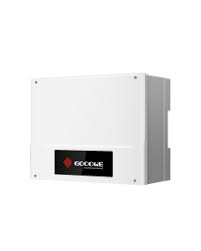I have 4 SPF 3000TL LVM-48P inverters.
I've had phase balancing issues with these since day one, but only with 2 inverters on one leg and two inverters on the other. I'd see lights flickering, the inverters resetting due to voltage fluctuation etc.
Weirdest part is I gave up on having one large system, and settled for two 120v systems, two inverters on each leg capable of outputting 6000 watts. This has worked perfect, no flickering lights no issues, but I really want 240v.
One option which could work for me is to still have two separate systems, but 1 inverter on each leg, paralleled for split phase. For some unknown reason this works great too. The only problem is I have to be really careful with my loads, since I only have 3000w available on each leg per pair. This is why I went with 120v system.
I recently saw Signature Solar has a growatt autotransformer that can handle 5000 watts of imbalance. I'm thinking I could use this autotransformer to create a neutral, and only pass L1 and L2 from the growatt inverters. My only problem, is I live in the NorthEast and I fall back to the Grid often in the winter. Are autotransformers safe to use for the neutral, when the Growatt inverters are in bypass and just passing the gird through? Also, seems to be some confusion, at least on my part of how to wire the neutral, as well as neutral/ground bonding issues when on grid.
In my current setup the growatts have a relay which does not bond neutral/ground, if it detects the grid input, but a relay bonds neutral to ground if not.
I've had phase balancing issues with these since day one, but only with 2 inverters on one leg and two inverters on the other. I'd see lights flickering, the inverters resetting due to voltage fluctuation etc.
Weirdest part is I gave up on having one large system, and settled for two 120v systems, two inverters on each leg capable of outputting 6000 watts. This has worked perfect, no flickering lights no issues, but I really want 240v.
One option which could work for me is to still have two separate systems, but 1 inverter on each leg, paralleled for split phase. For some unknown reason this works great too. The only problem is I have to be really careful with my loads, since I only have 3000w available on each leg per pair. This is why I went with 120v system.
I recently saw Signature Solar has a growatt autotransformer that can handle 5000 watts of imbalance. I'm thinking I could use this autotransformer to create a neutral, and only pass L1 and L2 from the growatt inverters. My only problem, is I live in the NorthEast and I fall back to the Grid often in the winter. Are autotransformers safe to use for the neutral, when the Growatt inverters are in bypass and just passing the gird through? Also, seems to be some confusion, at least on my part of how to wire the neutral, as well as neutral/ground bonding issues when on grid.
In my current setup the growatts have a relay which does not bond neutral/ground, if it detects the grid input, but a relay bonds neutral to ground if not.





